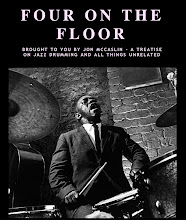
Drummer and author Malcolm "Mac" Santiago was very kind to forward me a copy of his latest book entitled "Beyond The Metronome: Becoming an Inchronus Musician".
Santiago defines the term "Inchronus" as the following:
in•chro•nous (ĭnʹ krôn- s) adj. Exhibiting an ability to play rhythm accurately in steady time without the aid of a metronome, recorded music, or other musicians . . . what many experienced musicians refer to as your internal clock.
Once I read his definition and introduction and understood that his book was about the topic of TIME, I was immediately interested and caught my attention. Developing a good sense and understanding of TIME should be a priority for any musician (not just drummers) of any style. Dealing with rhythm, and the issue of TIME specifically, is often accepted however how it is to be taught effectively and implemented often remains a mystery for many students and teachers of the music. Many people recognize the importance of having good TIME but when it comes to explaining how to teach that concept, many often just say "play along with a metronome" or shrug their shoulders. Well, there is obviously more to the science of musical time than simply playing along to a steady click and drummer/author Mac Santiago has developed a very interesting method and set of philosophies to help develop, specifically, a musician's "inner clock" and further one's feeling of TIME at a deeper, more personal level rather than simply being able to follow along with a click or metronome (but of course that's certainly that's part of it as well).
The book includes a CD containing .mp3's of various metronomic "click" exercises and routines at different tempos, all developed with the aim of improving one's sense of internal time. The overall goal of this book is to help us develop a strong personal sense of time without relying too much on external references. The author has done this by focusing on working with recorded click tracks designed to force one to rely on there own personal clock. For example, by working with "elongated" click tracks (click tracks where the subdivision gradually changes from quarter notes to half notes, to whole notes, etc.) and "diminished" tracks (where the pulse remains constant however the volume gradually decreases) one is required to shed any rhythmic insecurities one might have in order to properly execute a particular exercise and concept. Challenging stuff indeed !
The book is divided into two parts: Part One "The Tools of Inchronation" and Part Two "Concepts and Applications" and all the chapters use the extensive accompanying click track exercises contained on the CD.
The first part "Tools of Inchronation" deals with what Santiago describes as "concepts and exercises to help you get a deeper understanding of what steady time feels like - recognizing it, internalizing it, and finally creating it in the manner of your choosing" and the second part "Concepts and Applications" deals with "some real-life experiences that every musician goes through when exploring rhythm and tempo".
Between Santiago's well thought out explanations and philosophies of our relationship to the concepts of pulse, rhythmic subdivisions, etc. and the technical click exercises contained on the CD, this is overall an excellent resource to invest some time in if you are serious about furthering your personal relationship to TIME and rhythm.
You can find further information regarding this unique approach and resource to developing your sense of time here:
http://inchronicity.com/




















No comments:
Post a Comment